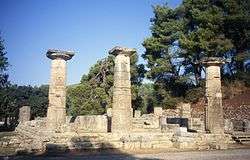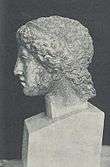Heraean Games



The ancient Heraean Games were known to be a series of athletic events in which only women athletes participated. This event was held to honor the Greek mythological goddess Hera. Just like the Olympic games, Heraean Games were held once every four years, but it isn't cleared to whether the Heraean Games were part of the Olympiad cycle and if it was, at which point of the four-year cycle it was held on. The stadium that held the Heraean Games was the same stadium where the ancient Olympic Games was held and Pausanias confirmed this along with the fact that the stadium had a different track for women athletics which was 5/6 the length of the original track used by men athletes. The length of the original track is 212.5 meters long which will make the women's track 177 meters long. Because these games were held in ancient times, the Heraean Games only included events such as running sports and combat sports were not played by women athletes. The four main running events during the Heraean Games included:
- Stadion - a sprint race on the women's track (177m).
- Diaulos - a two-laps race on the women's track (354m).
- Hippios - a four-laps race on the women's track (708m).
- Dolichos - an 18-24 laps race on the women's track.
The Competitors were all women in the Heraean Games. Unlike the male athletes in the Panhellenic games, Women athletes did not play in the nude and wore tunics which had the length till their knees. These were the same tunics for men who performed physical labor.8 [1]
No real date can be proved when these games had started but historians are able to predict from the writings done by a Greek geographer, Pausanias. They predict the approximate start of the Heraean Games to be slightly sometime after the start of the Olympic Games, during 776BC. The end of the Heraean Games also is not proved due to the lack of information available to historians today, but predictions can be made which is found to be in 393 AD after the religious festivals like Panhellenic games being banned by the Roman emperor Theodosius. Records and writings of the ancient Heraean Games are very low in numbers which all the information available to us today are from the writings of Pausanias.9 [2]
The Heraea champions won olive crowns, cow or ox meat from the animal sacrificed to Hera and the right to dedicate statues inscribed with their names[3] or painted portraits of themselves on the columns of Hera's temple. It is still apparent where the portraits were attached on the temple, though the artwork itself has disappeared.[4] The women competed in three age groups. Pausanias describes their appearance for the races such that, "their hair hangs down, a tunic (chiton) reaches to a little above the knee, and they bare the right shoulder as far as the breast.".[3]
We do know women were forbidden from competing in or even viewing the Ancient Olympics, under penalty of being thrown from the cliffs of Mount Typaion. Girls were not encouraged to be athletes. Those raised in Sparta were the exception, where they were trained in the same athletic events as boys, because Spartais believed that strong women would produce strong future warriors. These girl athletes were unmarried and competed nude or wearing short dresses. Boys were allowed to watch the athletes, in the hopes of creating marriages and offspring. A race dedicated to Dionysus (god of wine and pleasure) may have also been a community rite of passage.[5]
Heraea could have been an indication of changing social conditions and an easing in restrictions on women, or it could have been a temporary change. Greek women were allowed to compete in the same festivals as men after the classical period. The dearth of references is evidence that these changes may have been unwelcomed Roman influence. In Rome, girls from wealthy families were allowed to participate in men's festivals. A Delphi 1st century AD inscription tells that two young women competed in races (not the Olympics), possibly in women's races at the Sebasta festival in Naples (during the imperial period) and in Domitian's races for women at the Capitoline Games in Rome, 86 AD.[5]
References
- ↑ "Ancient Heraean Games - Health and Fitness History". Health and Fitness History.
- ↑ "A Perspective of the History of Women's Sport in Ancient Greece" (PDF). Journal of Sport History.
|first1=missing|last1=in Authors list (help) - 1 2 Pausanias. "Pausanias 5.15.1-6". Olympia - Pausanias' Description of Greece. Archived from the original on November 9, 2005. Retrieved February 18, 2006.
- ↑ Swaddling, Judith. "Women at the Heraia". Ancient Greek Olympics Gallery. Retrieved February 18, 2006.
- 1 2 Scanlon, Thomas F. "Games for Girls". "Ancient Olympics Guide". Retrieved February 18, 2006.